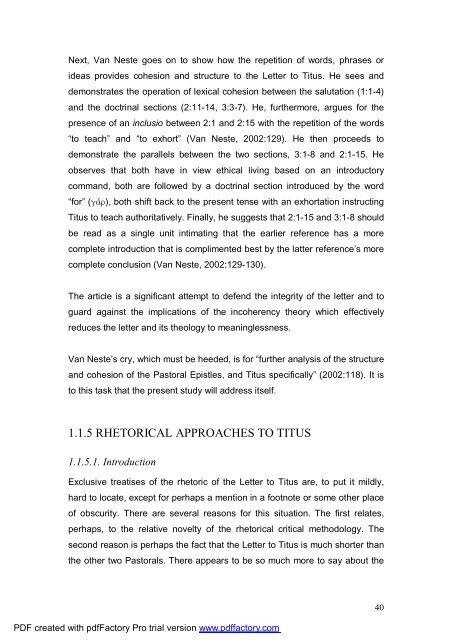A Text centred rhetorical analysis of Paul's Letter to Titus
A Text centred rhetorical analysis of Paul's Letter to Titus
A Text centred rhetorical analysis of Paul's Letter to Titus
You also want an ePaper? Increase the reach of your titles
YUMPU automatically turns print PDFs into web optimized ePapers that Google loves.
Next, Van Neste goes on <strong>to</strong> show how the repetition <strong>of</strong> words, phrases or<br />
ideas provides cohesion and structure <strong>to</strong> the <strong>Letter</strong> <strong>to</strong> <strong>Titus</strong>. He sees and<br />
demonstrates the operation <strong>of</strong> lexical cohesion between the salutation (1:1-4)<br />
and the doctrinal sections (2:11-14, 3:3-7). He, furthermore, argues for the<br />
presence <strong>of</strong> an inclusio between 2:1 and 2:15 with the repetition <strong>of</strong> the words<br />
“<strong>to</strong> teach” and “<strong>to</strong> exhort” (Van Neste, 2002:129). He then proceeds <strong>to</strong><br />
demonstrate the parallels between the two sections, 3:1-8 and 2:1-15. He<br />
observes that both have in view ethical living based on an introduc<strong>to</strong>ry<br />
command, both are followed by a doctrinal section introduced by the word<br />
“for” (gavr), both shift back <strong>to</strong> the present tense with an exhortation instructing<br />
<strong>Titus</strong> <strong>to</strong> teach authoritatively. Finally, he suggests that 2:1-15 and 3:1-8 should<br />
be read as a single unit intimating that the earlier reference has a more<br />
complete introduction that is complimented best by the latter reference’s more<br />
complete conclusion (Van Neste, 2002:129-130).<br />
The article is a significant attempt <strong>to</strong> defend the integrity <strong>of</strong> the letter and <strong>to</strong><br />
guard against the implications <strong>of</strong> the incoherency theory which effectively<br />
reduces the letter and its theology <strong>to</strong> meaninglessness.<br />
Van Neste’s cry, which must be heeded, is for “further <strong>analysis</strong> <strong>of</strong> the structure<br />
and cohesion <strong>of</strong> the Pas<strong>to</strong>ral Epistles, and <strong>Titus</strong> specifically” (2002:118). It is<br />
<strong>to</strong> this task that the present study will address itself.<br />
1.1.5 RHETORICAL APPROACHES TO TITUS<br />
1.1.5.1. Introduction<br />
Exclusive treatises <strong>of</strong> the rhe<strong>to</strong>ric <strong>of</strong> the <strong>Letter</strong> <strong>to</strong> <strong>Titus</strong> are, <strong>to</strong> put it mildly,<br />
hard <strong>to</strong> locate, except for perhaps a mention in a footnote or some other place<br />
<strong>of</strong> obscurity. There are several reasons for this situation. The first relates,<br />
perhaps, <strong>to</strong> the relative novelty <strong>of</strong> the <strong>rhe<strong>to</strong>rical</strong> critical methodology. The<br />
second reason is perhaps the fact that the <strong>Letter</strong> <strong>to</strong> <strong>Titus</strong> is much shorter than<br />
the other two Pas<strong>to</strong>rals. There appears <strong>to</strong> be so much more <strong>to</strong> say about the<br />
PDF created with pdfFac<strong>to</strong>ry Pro trial version www.pdffac<strong>to</strong>ry.com<br />
40

















